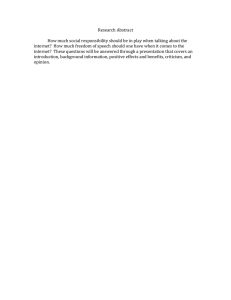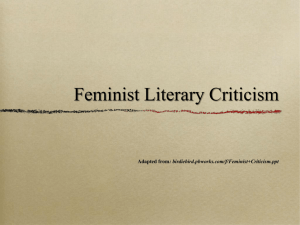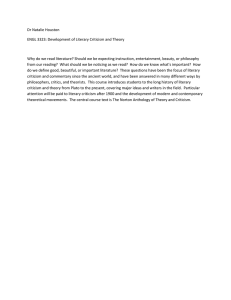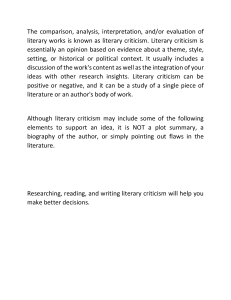Literary Criticism: Feminist, Reader Response, Post-Colonial
advertisement
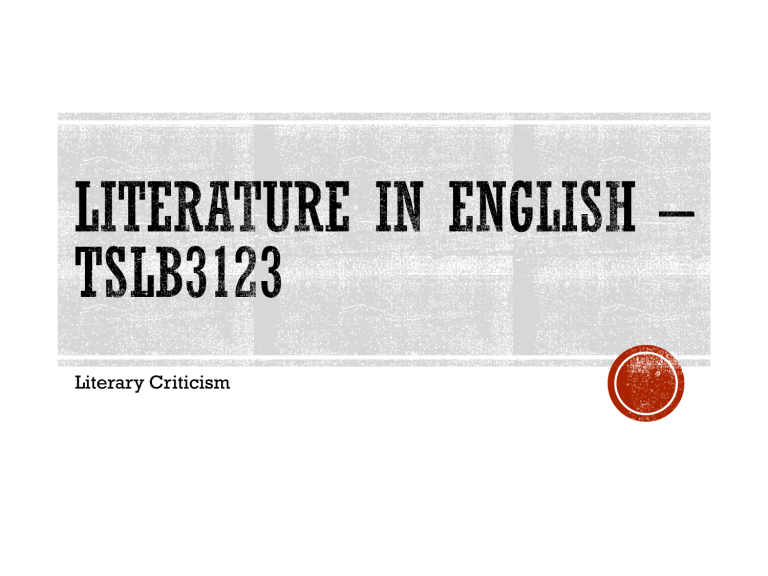
Literary Criticism A face? ... Or, the word 'liar' ? Looking at the things/objects/texts from different perspectives. The practice of describing, interpreting, and evaluating literature (Morner and Rausch, 1998:121) •Literary Criticism helps readers understand a text in relation to the author, culture, and other texts. Literary criticism is the method used to interpret any given work of literature. The different schools of literary criticism provide us with lenses which ultimately reveal important aspects of the literary work. Critical Lenses are different perspectives through which the reader can “view” a text. Talking about experiences enhances our enjoyment of them Talking about experiences involves the search for meaning which increases our understanding of them Because Socrates said so: "The life which is unexamined is not worth living." Literary criticism helps us to understand what is important about the text its structure its context: social, economic, historical what is written how the text manipulates the reader the relationship between authors, readers, and texts The act of literary criticism ultimately enhances the enjoyment of our reading of the literary work Remember, literary criticism is used by readers to analyze, NOT by authors to write. Therefore, when you begin to analyze your novel, you’ll make use of expert, reliable literary criticism to support your opinion—your thesis—which you will develop for your paper. We are going to look at 3 theories of literary criticism - Feminist criticism - Reader Response criticism - Post – colonial criticism Feminist criticism is the literary and critical theory that explores the bias in favor of the male gender in literature, and which reexamines all literature from a feminist point of view. A type of literary criticism that critiques how females are commonly represented in texts, and how insufficient these representations are as a categorizing device. They focus on how femininity is represented as being passive and emotional – the “caregiver,” and the male is associated with reason and action – the “doer.” As an addition to the feminist movement in politics, the feminist critique of literature seeks to raise the consciousness about the importance and unique nature of women in literature, and to point out how language has been used to marginalize women. whore, hussy, spinster, hag You’re just a woman…. Remember Trifles by Susan Glaspell? Specifically, the feminist view attempts to: 1. Show that writers of traditional literature have ignored women and have presented misguided and prejudiced views of them 2. Create a critical landscape that reflects a balanced view of the nature and value of women 3. Expand the literary canon by recovering works of women of the past and publication of contemporary female writers 4. Urge transformation in the language to eliminate inequities and inequalities that result from linguistic distortions such as mankind (rather than humanity). 1. To what extent does the representation of women (and men) in the work reflect the time and place in which the work was written? 2. How are the relationships between men and women presented in the work? 3. Does the author present the work from within a predominantly male or female perspective? 4.How do the facts of the author’s life relate to the presentation of men and women in the work? 5. How do other works by the author correspond to this one in their depiction of the power relationships between men and women? 1. In what ways is patriarchy present in a particular work? How are the effects of patriarchy evident in the lives and attitudes of the characters? 2. Do female characters show signs of resistance to patriarchy? If so, how is this resistance portrayed? 3. How are the concerns unique to women in a particular place/time portrayed in the work? To what extent does this portrayal value those concerns? Does Hermione Granger get the credit she deserves? A Feminist critic, would analyze Juno. These pictures depict her as: confident, powerful, equal, firm, at peace, dauntless, self-sufficient, co-owning, secure, judged but able to withstand, even bolder than her “man” Now look at these pictures …… A Feminist critic would analyze Twilight. These pictures depict her as: insecure, submissive, dependent, reliant, protected, main but lesser, sustained by, accessory, strong because of, empowered by, obedient, even slavish (1) Rethink the canon—the accepted “greats” of all- time—to include women authors, poets, directors, actors (2) Examine representations of women in literature and film by male and female authors & moviemakers (3) Challenge representations of women as “Other”, as “lack”, as part of “nature” (whereas, men are part of “culture” and better than “natural” or “emotional”) (4) Raise the question of whether men and women are “essentially” different because of biology, or are socially constructed as different (subjugating women as “worse” than men in the important ways) Become an aware Feminist literary critic: What are your problems with this novel? What female qualities are shown as weak, bad, pathetic, negative? What masculine qualities are shown as strong, good, powerful, positive? How does your gender affect your reading/interpretation? What is the protagonist’s attitude to male and female characters? How is this evident? How does this affect your response to the characters? · How are women represented in the text? What roles do men and women play within family, work situations, etc. (hero, breadwinner, helper, cook, sex object)? What were the social and historical conditions for women in this period that might help us understand their roles in the text? · How do women exercise their power in the text? · If you were to rewrite the text’s ending, what would happen to the female protagonist? The male protagonist? How and to what degree are the women’s lives limited or restricted in this text? Mary Maloney, a devoted seemingly obsessed and pregnant housewife, expects her husband Patrick to return home from his job as a local police detective. • When he returns, Mary notices that he is strangely aloof and assumes that he was tired from work. • Patrick finally reveals to Mary what is making him act strangely. • Dahl does not reveal what is discussed, but it is presumed by many that Patrick tells Mary that he was going to leave her for another woman. Seemingly in a trance, Mary fetches a large leg of lamb from the deep-freezer in the cellar to cook for their dinner. • Patrick angrily tells Mary not to make him any dinner, as he is going out. •She strikes Patrick in the back of the head with the frozen lamb leg, killing him. •Mary realizes that she has killed Patrick and has to create a story to tell the detectives. •She prepares the leg of lamb that she has killed her husband with and places it in the oven to somewhat destroy the evidence. •After practicing a cheerful routine, she visits the grocer to establish an alibi. Upon returning, she enters the room with her dead husband lying on the floor and calls the police. When the police (who are all friends of her husband) arrive, they ask Mary questions and look at the scene. • Considering Mary above suspicion the police conclude that Patrick was killed with a large blunt object, likely made of metal. • After a fruitless search around the house and surrounding area, Mary is reminded the leg is cooking, and offers it to the policemen, which after hesitating they accept. • During the meal they discuss the murder weapon's possible location. • One officer says it is "Probably right under our very noses". • Mary overhears the last line and begins to giggle. ‘Lamb to Slaughter’ is written in a manner which deteriorates the values of women. • Mary Maloney is a housewife, who is six months pregnant. • She loves her husband very much. “She sets down her sewing … took his coat and hung it in the closet” • That is a very descriptive quote about the style if how this story was written. • It says two things. One that women stay at home and sew all day, which is a stereotype, and two, that she is there to serve. She is always trying to be comforting to Patrick. • For example, upon reaching Patrick who has just come back form works, she asks to prepare food for him which he refused repeatedly. • this shows how a woman IS portrayed to carry the woman roles, socially as a housewife. Mary Maloney is a victim of Patrick’s disrespect and verbal abuse. “For God’s Sake” and “Sit Down” were some of the disrespectful things and commands yelled at her. • Dahl wrote this in a way in which Patrick orders her to do things when she is being polite and courteous to him. • Patrick has obviously shown the quality of patriarchy where man overpowers woman. He has little respect for her and snaps at her when she offers him food and drinks. • This leads her to kill him because she couldn’t take it anymore. He just overwhelmed her. After she kills him and the investigators come, they were, “exceptionally nice to her” automatically rendering her and unlikely suspect because she is a woman. • She, in the minds of the investigators, is to frail or weak to do such a thing. • She offers them drinks and food making her less likely than she already was, which was pretty much innocent, to be the murderer. • They give her special treatment because she is a woman and don’t investigate her as much as they would if she was a man. This story, “Lamb to the Slaughter”, singles out the woman making her be regarded as a servant and inferior, disrespectfully treated and spoken to by her husband, and unable to commit a crime because she is a woman, while being given special treatment by the investigators because of her gender. Part 1 Work in groups of 3 Read the story –A Rose for Emily –William Faulkner Analyse the story using the feminist criticism. Part 2 Find any short story that you have read and analyse the story using the feminist criticism. Present your findings to the class
